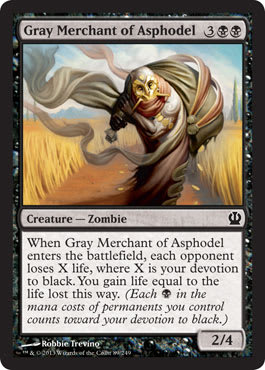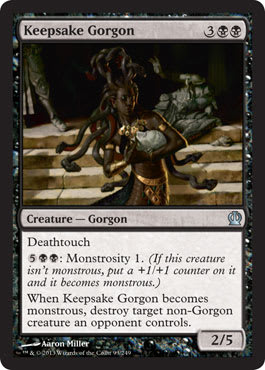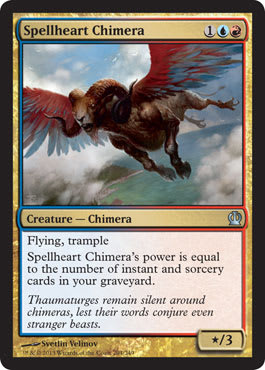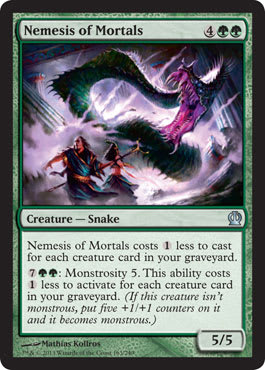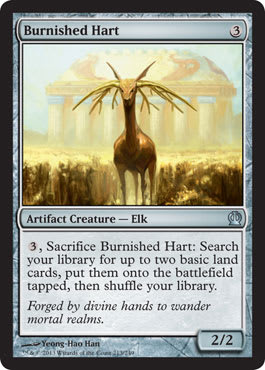With the contents of Theros now fully revealed, those of us who live to build forty-card decks can start thinking about what really matters: drafting. While a lot of early speculation centers on pick orders and which colors are generally strong, after you draft a few hundred or a few thousand times, evaluating cards in a vacuum is sort of automatic, though still challenging. When I look at a new set's card image gallery now, I'm looking for synergies that will set my deck apart. I'm looking for cards the values of which are very different in this set than they would be in most sets.
To that end, I've laid out five speculative decks I want to try in my early Theros Drafts.
Phalanx Leader
Core Enablers
It's clear that a lot of the cards in Theros exist to make heroic work; a pile of marginal Auras that each draws a card would be strange without this mechanic to explain it. Among heroic creatures, though, Phalanx Leader offers a unique benefit affecting your entire board. Similar effects distributing +1/+1 counters have been printed at ![]()
![]() (Titania's Boon) and at
(Titania's Boon) and at ![]()
![]() (Thrive), but the better comparison is Travel Preparations, which showed the power of parceling out counters to more than one creature repeatedly. This is definitely closer to what you should aim for with Phalanx Leader, and in general, it should be very powerful to trigger it twice with any reasonably developed board; triggering three or more times should be crushing since that approaches a permanent Overrun.
(Thrive), but the better comparison is Travel Preparations, which showed the power of parceling out counters to more than one creature repeatedly. This is definitely closer to what you should aim for with Phalanx Leader, and in general, it should be very powerful to trigger it twice with any reasonably developed board; triggering three or more times should be crushing since that approaches a permanent Overrun.
I expect this deck to be W/B, but it could be R/W sometimes on the value of Akroan Crusader tokens. The R/W version might be what you audible into if the Draft isn't going your way.
Better in This Deck than Average
- Evangel of Heliod
- Hopeful Eidolon
- Traveling Philosopher
- Yoked Ox
- Fate Foretold
- Lost in a Labyrinth
- Ordeal of Thassa
- Voyage's End
- Priest of Iroas
One of the attractions of this deck is that you can reserve early picks for the Leader and heroic enablers that will be desirable to most of the other drafters, and you’ll presumably pick up some of these cards late to round out your deck. (Imagine the feared Yoked Ox beatdown strategy.) This deck wants cheap, nonheroic creatures more than most heroic decks because you want to play the Leader last, preferably with a way to trigger it the same turn to minimize exposure to removal. Voyage's End is particularly well-suited for targeting Leader in response to removal—you still put the counters on your other creatures, and the Leader lives to try again.
I'm not dwelling on rares in this article, but Gift of Immortality is one to watch for given how much better the deck is when it can keep Phalanx Leader on the board. In related news, any Ordeal is easier to trigger when you spray counters onto the board with Leader.
Life-Leech
Core Enablers
This is the devotion-to-black deck, and Gray Merchant is the reason it exists. Bloodhunter Bat was desirable in Magic 2013 drafting, but Gray Merchant has downsides (1 more mana, no flying) that outweigh its extra toughness. The difference is that the life it drains can be much larger, but most decks can't fully capitalize on it. As a result, you can hope to pick up most of the Gray Merchants at the Draft table if no one else is specifically pursuing it. Only other majority-black drafters should have much interest.
Even with all of the Merchants, though, and assuming that scry cards dig through your deck fast enough to draw multiples, you need more to count to 20. Rescue from the Underworld helps, but it's strong enough in other decks that you can't count on having it. I think Scholar of Athreos is the missing ingredient: It's a small white splash that matters most very late in the game, but it isn't strictly capped in its life-drain effect. Because W/B doesn't have a ton of synergy in the set's main mechanics, the Scholar should be an easy piece to pick late. Scholar also collaborates happily with the large amount of mana needed to guarantee casting 5-mana creatures on schedule and the low amount of scry to skip drawing extra lands.
Better in This Deck than Average
- Vanquish the Foul
- Baleful Eidolon
- Disciple of Phenax
- Keepsake Gorgon
- March of the Returned
- Returned Phalanx
It's possible that this deck wants to directly attack the opponent less than any other deck in Theros Limited. Having multiple 5-mana 2/4s pushes you in that direction, so why not embrace it by including a 5-mana 2/5? Keepsake Gorgon builds up the devotion count in addition to addressing two of the deck's weaknesses: Its monstrous trigger kills evasive creatures, and its deathtouch works against opposing monstrous creatures that are large enough to attack into a clogged board.
Since the deck's core plan gains extra life and drags the game out, March of the Returned gives us the chance to recast any Gray Merchants that die to routine blocking. Vanquish the Foul fits the expected white splash and provides another answer to the threats big enough that Merchants don't block profitably.
Izzet
Core Enablers
Who needs enchantments? This deck is operating perpendicular to Theros's enchantment theme, which is very attractive in Draft to gain more benefit out of later picks. The reason this deck might not come together is high demand from other players for Prescient Chimera as the best common flyer and for red, based on Lightning Strike and Magma Jet. If you can't pick up more than one Prescient or Spellheart Chimera, it's hard to deviate far from a generic U/R deck.
Better in This Deck than Average
This deck capitalizes on the minimal amount of flying in the set, particularly cheap flying (Wingsteed Rider is the main competition below 5 mana), so Vaporkin can be a very important early play to whittle down the opponent's life. Crackling Triton is simply a card few others want because of the color restrictions and lack of synergy. The chance to be the best Prescient Chimera deck also boosts Flamespeaker Adept since more cards functionally gain scry, and the ones with it built in will cause two triggers.
The most surprising card on the list is Demolish, a perennial reprint that's usually picked twelfth through fourteenth in every set. However, monstrosity pushes us to care about making it to 7 or more mana in every game—even more than Innistrad's flashback did. Being the only deck that gains a benefit from casting sorceries while also being a deck particularly weak to a monstrous Nessian Asp means Demolish is better than normal here. Land destruction can also "turn off" the opponent's scrying benefits (he or she is able to put a land on the bottom of his or her library less often), helping the Izzet player pull further ahead. Demolish won't be consistently great, but I'm much more interested than in most sets.
I list Boon of Erebos because there's probably a U/B version of this deck (maybe using a March of the Returned/Mnemonic Wall engine), and Boon's regeneration clause matters a lot in a deck relying on a few evasive threats to win. The +2/+0 portion also lines up Prescient Chimera to kill Nessian Asp.
Nemesis of Mortals
Core Enablers
The Nemesis is definitely good enough to craft a deck around, and it asks for the most natural plan in Limited: a green deck that's mostly creatures. The best companion spell, Commune with the Gods, is conveniently similar to Impulse in Limited play. One of the virtues of this deck is that it doesn't devalue the cards that would be good most of the time, and it lets you draft a deck that works differently because it's looking to leverage a key card.
Better in This Deck than Average
The main version will probably be B/G to take advantage of a fuller graveyard than most decks provide, potentially recurring a plausible 10/10 threat with either March or Mender.
Satyr Hedonist casts a plausible turn-three Nemesis for the R/G version of this deck. Besides Voyage's End, it's almost impossible for the opponent to stop Nemesis for less than 6 mana. While the Hedonist plan shouldn't be central to the deck, it shouldn't be ignored just because rituals like Infernal Plunge and Pyretic Ritual have been bad cards in past sets. A ![]()
![]() 2/1 is disappointing, but it’s not a blank card on its own.
2/1 is disappointing, but it’s not a blank card on its own.
Monstrosity Ramp
Core Enablers
Whether this deck exists hinges on how many drafters want the ramp effect of Hart and Unicorn to support their own monstrous creatures and whether the monstrous creatures are reliable enough that it's worth a severe investment to use them. The idea here is that Theros might reverse the factors that usually make ramp risky: It is mana-flooded and has disproportionately bad top-decks, and it's hard to guarantee that there are sufficiently large creatures in the environment to ramp to, much less that you’ll draw them. However, scry cards can mitigate the mana and top-deck issues, and monstrosity means there are a lot of outlets to pay 6 or more mana—once to cast and once to activate monstrosity.
Assuming the deck exists, it naturally supports more than two colors, particularly through Burnished Hart. This makes it easier to pick whichever monsters appear in the packs.
Better in This Deck than Average
- Sea God's Revenge
- Boulderfall
- Nylea's Presence
- Voyaging Satyr
- Guardians of Meletis
- Flamecast Wheel
- Unknown Shores
Cards such as Nylea's Presence and Voyaging Satyr help pay some of the restrictive monstrosity costs, with Presence digging toward the key cards and Satyr acting as a sort of Star Compass ramp effect. Flamecast Wheel and Guardians of Meletis are more desirable to this deck because they help spend all the early mana efficiently and provide defense while the probably-awkward mana base assembles. Boulderfall—and to a lesser extent Sea God's Revenge—are the post-monstrous ways to leverage excess mana, clearing the way for big attackers.
It's uncertain for now whether any of these decks will turn out to be successful; Theros has been widely characterized as hard to evaluate, from the Gods on down to the most common mechanics. My instincts tell me that most of the core cards I've discussed are true format pillars, even if they shape up to work differently than the supporting cast I've described for each of them. Happy drafting!


















